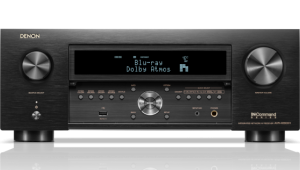Test Report: Yamaha YSP-2200 Digital Sound Projector Page 2
I needn’t have. Yamaha’s “IntelliBeam” auto-setup routine works from a small mike that you place at the primary listening position. After a suggestion that you leave the room (Yamaha’s engineers presumably don’t want your soft, absorptive body blocking the required reflections), the usual parade of noise bursts proceeds. But instead of leaving, I sat in my listening position with the mike on a small tripod directly in front of my nose, which after all will be there during actual use. You can almost hear the process working: The YSP-2200 “hunts” for reflective sweet spots, adjusting the angle and amplitude of its surround-channel beams until it acquires a satisfactory result.
Since the YSP-2200 requires no receiver or amplifier, setup is mostly a question of plugging it into the wall, connecting the sub, and linking a single HDMI cable to a TV, preferably one that features an HDMI 1.4 port with Audio Return Channel. (There are no other video inputs beyond the 3 HDMI jacks.)
Performance
In my room, the Yamaha’s ability to produce big, broad, involving sound from a single, compact physical source was astonishing. One of the first things I played on the YSP-2200 was a baseball game, presented in fairly effective Dolby Digital, and the Yamaha’s conjuring of a true bubble of ambience encompassing the listening position was hugely impressive.
The “Gladiator-lite” movie The Eagle is a grim and humorless affair (with a cast sadly in need of acting lessons, plus a rather embarrassed Donald Sutherland), but it at least can boast a competent DTS-HD Master Audio soundtrack. And the opening minutes were enough to prove that the YSP-2200 can do film sound convincingly, as the rustlings of nature along the riverbank quietly drew me in. Chapter 3, the first battle scene (of many), showed that big action was well within the little Yamaha system’s reach, as thundering hooves, clanging swords, and grunting extras — er, Britons and Romans — spread energetically across the front hemisphere. (I didn’t spot any wristwatches, but I’ll bet there was one.)
You may note that I’ve made no mention of effects panning past, or ambience extending much beyond or behind the listening seat. The surround it does produce is very effective and entirely unobtrusive, but it did not convey quite the full 360° envelopment of my five-speaker setup. It was more like a cardioid pattern reaching just a bit beyond your shoulders.
At the same time that it was crumbling my faith in the laws of physical psychoacoustics (a field I just made up), the Yamaha also revealed two weaknesses of “beamed” surround, at least as compared with discrete-speaker 5.1 layouts. First, centered voices (announcers) took on a very slight but discernible coloration: just a tinge of a slap-back, and a slightly nasal tone. (This was much less evident on “straight” surround than on Yamaha’s Cinema DSP modes, and not at all in stereo.) Second, broadband effects — applause and cheering, for example — in the surround “channels” were presented with a slightly comb-filtered, or “phasey” effect. This too was very mild but consistent. Interestingly, more narrow-band effects, like sirens or birdsong, did not exhibit this shift.
On music, the YSP-2200 proved serviceable. Compared with one of my long-term compact monitor pairs (without subwoofer support), its balance through the critical lower-midrange was very close, meaning it was impressively accurate. The Yamaha in Stereo mode had a noticeable lack of sparkle and “air” over the top octaves.
Tilting up the sub box also helped make the lower-midrange sound more unified, since the bass box contributes plenty of sound well above 100 Hz. And while the YSP-2200 sub produces satisfactory bass extension for casual home theater and music playback, its extension is modest, falling off rapidly below, at a guess, 50 Hz.
Since I just had to know, I ran a quick frequency-response sweep on the YSP-2200’s sub output and found that it crossed over at 400 Hz and was high-passed below about 50 Hz, no doubt to protect the little woofers. It also produced about 10 watts maximum to the sub. For a lark, I tried piggybacking a 12-inch active sub, set for very low low-pass, to span the missing octave-plus with great effect. I’d recommend this adaptation to anyone planning a “serious” YSP-2200-based system.)


















































